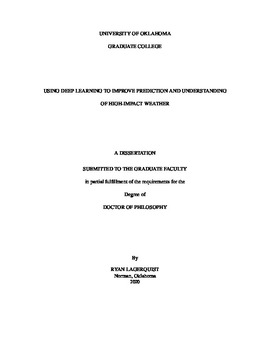| dc.description.abstract | This dissertation describes the application of convolutional neural networks (CNN), a type of deep-learning method, to high-impact weather. CNNs are specially designed to learn directly from spatial grids, which improves both skill and interpretability.
Specifically, I develop and test CNNs for two tasks. The first is tornado prediction, where the two CNNs predict next-hour tornado occurrence for a given storm, using datasets similar to those used by forecasters in real-time operations. The tornado models achieve an area under the receiver-operating-characteristic curve (AUC) of 0.94 and critical success index (CSI) of >~ 0.30. This is competitive with a machine-learning (ML) model currently used in operations, which suggests that the CNNs would also be suitable for operations. Novel ML-interpretation methods highlight the importance of a deep reflectivity core and strong mesocyclone, as well as low-level instability and wind shear in the surrounding environment. Also, interpretation methods suggest that a rear-flank downdraft with too much precipitation and negative buoyancy can lead to tornadogenesis failure, which corroborates some previous literature.
The second task is front detection, where the CNN draws warm and cold fronts in reanalysis data. When evaluated on human-identified fronts, the CNN achieves a CSI of 0.29 and frequency bias of 2.03. Although this is a high frequency bias, visual analysis suggests that the humans often miss fronts, so this "overdetection" is considered acceptable. I use the CNN-detected fronts to create a 40-year climatology over North America and the surrounding oceans. To my knowledge, this is the only climatology that separates fronts by type (warm or cold), one of only two climatologies that investigate variability with respect to the El Niño - Southern Oscillation (ENSO) over a continent-scale or larger domain, and one of only three that investigate long-term trends over a continent-scale or larger domain. I find that fronts are most common in the mid-latitude cyclone track, which migrates poleward from winter to summer, equatorward during El Niño, and poleward during La Niña. Also, I find that the cyclone track appears to be migrating poleward as a consequence of global warming. These results are broadly consistent with previous climatologies, although there are some discrepancies and interesting results that warrant future investigation.
To summarize, my contributions to atmospheric and data science include creating tornado models that perform competitively with the state of the art, using novel interpretation methods to understand physical relationships learned by the tornado models, creating a front-detection model that appears to overcome some deficiencies of human labels, using the front-detection model to create a climatology, and identifying similarities and discrepancies to the few pre-existing climatologies. Overall, this dissertation demonstrates that deep learning can be used to advance both the prediction and understanding of high-impact weather. | en_US |

